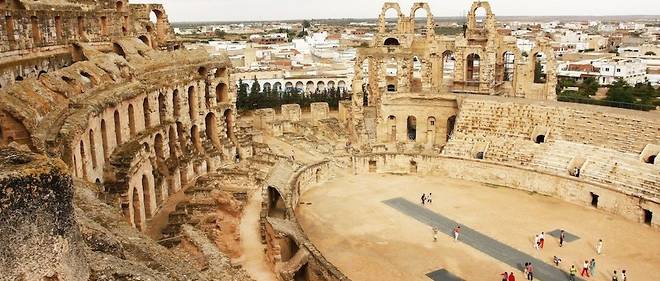El Jem is attached to the governorate of Mahdia, and has about 19,000 inhabitants.
Its amphitheater is the largest in the Roman Empire (between 27,000 and 30,000 spectators) after the Colosseum in Rome (45,000 spectators) and that of Capua. Every summer since 1985, it has hosted the El Jem International Symphonic Music Festival.
In Roman times, the city of Thysdrus developed thanks to its advantageous position on a plateau dominating the sebkhas (salted, dry lakes), the most direct point of passage to go from north to south. The city is, from the second century, among the most prosperous in the Roman world. The amphitheater will remain the jewel offered by this civilization.
The city of Thysdrus benefits from an active policy of land reclamation and economic development: the emperors Vespasian and Titus bring water there through the proconsul of Africa. Thus, from the second century, it appears, according to the expression of Gilbert-Charles Picard, as the “oil capital” of Byzacene.
Legend has it that He would have served as a refuge for the Kahéna, a Berber “princess” fighting against the Arab armies…

Smart construction
Built on the model of the Colosseum in Rome, El Jem takes advantage of advances in the art of construction. Manufacturers now know how to reduce blind spots and integrate operating elements, such as galleries passing below the arena and communicating with the outside.
The amphitheater is made up of tiers, the cavea, divided into three parts separated by balustrades and each served by a specific staircase. A podium is reserved for personalities and spectators are distributed according to the social hierarchy of the city.
In the arena, wild beast hunts and gladiatorial fights take place. A built-in floor allows access to the lower galleries. Below the arena, the two galleries are bordered by sixteen vaulted chambers in which the beasts are locked. A small gallery with two openings makes it possible to hoist the cages of the wild animals, thanks to a freight elevator, to the arena.
The monument also has a system for collecting rainwater, channeled through a network of pipes and discharged, after purification, into huge cisterns.
Part of the Colosseum was destroyed by the bey’s cannons in 1850, because rebels had taken refuge there.
An international festival
Since 1985, El Jem has hosted the International Festival of Symphonic Music, created by Mohamed Ennaceur.
Learn more HERE
Texte : © « ESCAPADES – L’amphithéâtre d’El Jem », Lepetitjournal.com












